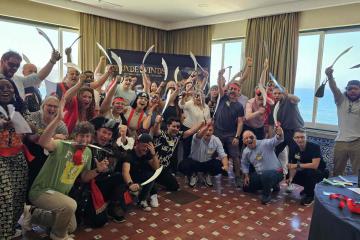The world around us is changing at a rapid pace. It's always been the case, but it seems like changes are following each other faster and faster. Technological developments are primarily the cause of this. Technology will play an even more significant role in the coming years and take over important tasks and functions from us. As a result, technology will impact the way we work and how we organize it. At the same time companies seem to choose a more humanistic approach to work. It's not just about creating as much shareholder value as possible. Organisations are increasingly looking at their social responsibilities and the development of their employees. There is more room for purpose, work happiness and energy at work.
As the digital world grows globally, soft skills such as communication, perseverance, solution orientation, collaboration and empathy are increasingly appreciated. Technology ensures that tasks are automated and taken over by robots, AI and computers.
There are several lists of skills of the future but which three skills are so vital that they can make all the difference in the current knowledge economy?
1. Empathy
Empathy is one of the most critical skills you can't automate. Empathy is about the ability to understand and share the feelings of other people and situations. It is essential that you can live in the world around you and you can adapt to the environment of others. It's all about the ability to deal with other people's behaviour, to get your way through social complexity and make personal decisions that deliver a positive result.
But why is this so important? Empathetic ability is an essential element of emotional intelligence. If you can feel with others, you understand their emotions better, and you can communicate more effectively. Without empathy, you talk over each other and conflicts arise in the workplace. Empathy begins with observing and understanding verbal and non-verbal messages from someone else or listening on an emotional level.
Empathy is indispensable among various teams. Empathy is all about reducing the barriers between culture, language, time zones and age so that you can make the most of the benefits of diversity.
Can you train yourself to be empathetic or is this an innate ability? Fortunately, you can boost your empathetic ability by following three simple steps.
Step 1 is active listening. Active listening is giving back what the other has said, in your own words. People with a lot of empathy can do this, even if they disagree with someone. How do you actively listen in a conversation?
- Do not interrupt the speaker during the conversation.
- Really listen (hear what the other says, instead of thinking what you're going to say right away).
- Ask further questions (that's how you show interest).
Step 2 is to increase the bond of trust. How do you strengthen a bond of trust with someone? You do this by being approachable and connecting on a personal level. A good working relationship is at least as important as listening carefully. If you know your colleagues a little more personally, you understand them better, how they might react and what their perspective is. How do you do all this? Talk about personal topics such as children, sports or current events (This must happen with genuine interest, or else it will be perceived as false).
Step 3 consists of letting the other know that you understand them or the situation. Pronounce this golden phrase: 'I understand you/it'. By expressing this phrase, your relationship with colleagues will grow stronger.
In a fractured world, can we hack our own sense of empathy and get others to become more empathetic? Professor, Department of Psychology, Stanford University Jamil Zaki research examines social cognition and behaviour, especially how people understand and respond to each other’s emotions. This work spans a number of domains, social influence, pro-social behaviour, and especially empathy . In addition to studying the mechanics of empathy, Dr. Zaki’s work focuses on helping people empathize better. Here he talks in depth about empathy.

2. Complex problem solving – critical thinking – creativity
Huh, there are three already? Yes, that's right, but we think these 3 have such deep connections to each jo that we treat them at the same time. To solve complex problems, you need to think creatively and critically.
Problem-solving power is from two parts:
- Identify the problem
- Choose the best solution
To identify the problem, you should be able to think critically. Looking at the issue from different perspectives will enable clear analysis.
When finding the right and best solution, creativity is needed. People develop, thanks to creativity. Creative thinking or creativity is the ability to come up with or work out new ideas. You apply original ideas as a solution to a problem or an issue.
Brainstorming conjures images of creative types sat around drinking coffee. This video shows us how individual creativity and some simple techniques can turn you into a one-person ideas factor.
To solve complex problems, various ways are possible. In basic, you almost always walk through the following 5 phases:
Identify the problem
Often this phase is underestimated. Solutions are frequently sought without looking closely at what the problem actually is about. It is essential to approach the problem from different angles and also to talk to several people who are dealing with the problem.
Brainstorm for solutions.
It is not about devising just one solution, but several solutions that can solve the problem. Creativity is required for original solutions.
Choose the right strategy and create a plan.
After careful consideration, choose one solution that has taken all aspects into account.
Implement the chosen solution/strategy.
This is where you create and implement an action plan.
Evaluate
Once you have chosen a course of action and put it into play, don't forget to observe and track whether it has been an effective solution to the issue at hand.

3. Work together
Number three is working together. It looks like an open door and maybe very logical. The speed of technological developments ensures that companies can only sporadically build a technological advantage. Information is available to everyone almost everywhere. The most successful companies in the future are the companies where employees work optimally together.
Collaboration is nothing more than pooling the abilities of each person involved The goal of working together is achieving a result together that would not be possible as an individual. By working together in a team, through togetherness and group feeling, an organisation can achieve more than the employee could alone.
Working together is often regarded as an important competence. Every employee should be able to do well. When you are helpful, friendly, courteous and honest, you have essential conditions to work together. You can listen carefully, motivate others and share your knowledge and experiences; these are the expressions of collaboration. If you have people knowledge, adaptability and communication skills, it opens doors to collaboration.
Working together is complex and relies on interrelational skills. Good collaboration is a team performance. In this video, John Spencer sets out the following 7 aspects pointing out that group work doesn't have to suck. He explores what makes creative collaboration work.
- Ownership
- Reliability
- Trust
- Structure
- Shared vision
- Fun
- Frank
Conclusion
The skills discussed cannot be replaced by computers. Employees who focus on this and develop these skills are too team players of the future. You can make a difference by investing in relationships with your colleagues. If you invest in these skills, you become more efficient and get a boost to meet your career goals. They're helping you to stand out. But there is always room for improvement.
What skills are you going to focus on in 2020?





